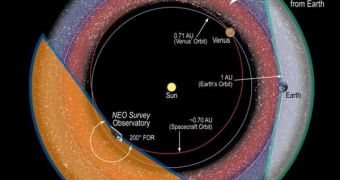For many years, experts with the American space agency have been arguing for the development of a space mission destined to find near-Earth objects before they become a threat. Now, increasing numbers of scientists are joining forces to support the proposal.
Earth's neighborhood is a very dangerous one, astronomers figured out some time ago. There are numerous space rocks such as meteorites, asteroids and meteors lurking around, just waiting for a chance to slam into our planet.
Experts know this to be true because they see these objects with their telescopes everyday. Additionally, tons of space debris fall from the sky everyday, generated by comets burning up in Earth's atmosphere.
The thing about these so-called near-Earth objects is that they are very hard to find until it's too late. They are extremely cold, and only a sensitive infrared telescope could determine their location on time.
But such missions are usually only developed to survey the deep space, and not look inside the solar system. Such a short-range system could be exactly what we need, experts believe.
The most common proposal for building a NEO defense system calls for placing a IR satellite in an Venus-like orbit around the Sun. this would give it an excellent vantage point over the entire inner solar system.
Another reason to press ahead with building a NEO detector is that US President Barack Obama has asked NASA that the agency put a crew on such a space rock by 2025.
Also, Congress requested the agency that it catalog as many as possible of near-by space rocks. This request gives NASA a free hand to require funds and workforce for building the spacecraft.
By the end of 2020, NASA needs to discover and keep track of more than 90 percent of all NEO that are larger than 140 meters in diameter. These are considered to be among the most dangerous of there.
“If we seriously want to find all the asteroids which could be an impact hazard to the Earth, as well as find the asteroids which would be good destinations for human spaceflight, then a space-based survey telescope in solar orbit interior to Earth's would be the most rapid way to do that,” says Lindley Johnson.
He holds an appointment as the NEO Observations Program Executive in the Planetary Science Division at NASA's Science Mission Directorate (SMD) in Washington, DC, Space reports.
“A spacecraft operating with sensors in the infrared band from an orbit sunward of Earth's (such as a Venus-like orbit) offers great advantages in rapid search and repeat observation frequency,” a report by a NASA Advisory Committee task force wrote last year.

 14 DAY TRIAL //
14 DAY TRIAL //